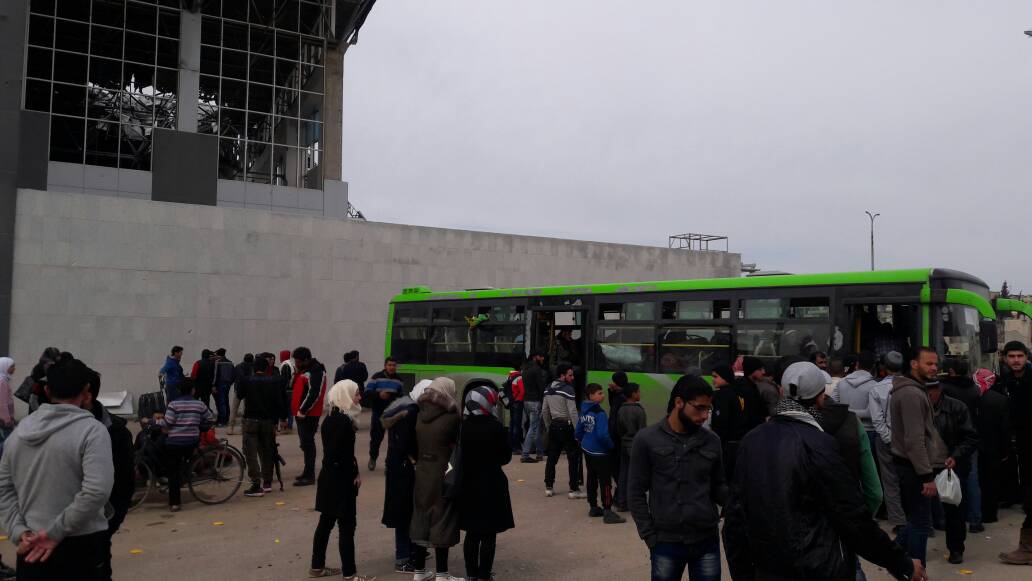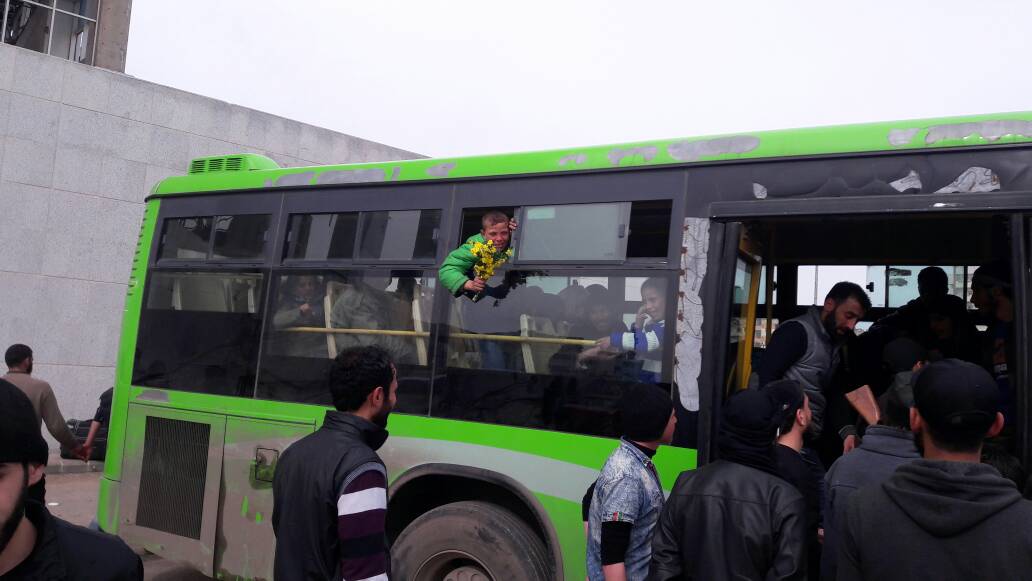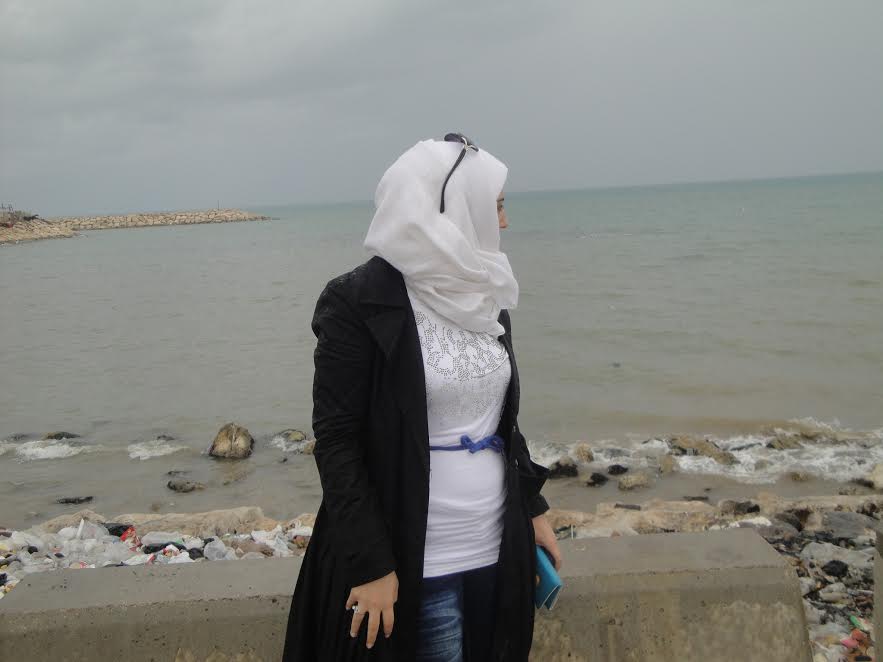(Al-Waer, Homs) “Idlib, Jarablus, or Homs northern countryside?” This is the question often asked by the residents of Al-Waer, west of Homs, when inquiring about each other’s different destinations. Rebels and their families are evacuating their last bastion in the city that has been dubbed “the capital of the revolution,” following a Russia-brokered agreement.
Ambiguity and Mistrust
As per the agreement, which was signed on March 13th, 2017, by both the regime delegation and Al-Waer Neighborhood Committee, the exodus will take place in batches, until the departure of the last person wishing to leave the district, at which point it will be handed over to the Syrian regime.
Since no substantial guarantees have been offered, many of the residents have opted to venture to the “unknown” instead of awaiting the “inevitable,” according to Ibtisam Al-Masri[i], a mother of four children. She emphasized that the fate of the district would at best be similar to that of Eastern Aleppo. “They will not leave anything unlooted,” she added, before stepping into one of buses that would take the fifth batch of exiles to Jarablus. “They will retaliate against all those who stay, which is why I’m leaving… no way could I stay and watch them murder us and raid our homes.”
The opposition media stress that the Homsi district is on the brink of descending into systematic demographic transformation engineered by the regime, as has been the case in cities such as Daraya, Al-Qusayr and Eastern Aleppo, all of which have previously been besieged and ultimately evacuated. However, the situation in Al-Waer is far more ambiguous and complex, and it is yet unclear whether the regime is actually willing to evacuate all of its inhabitants before deploying its forces.
Al-Waer evacuation deal has been peculiarly marked by the opening of crossings to allow civilian property owners to enter before the regime forces do so. It also included the option to remain for those willing, unlike what had happened in Eastern Aleppo, for example, whereby all civilians had been evacuated before regime forces entered.
Nonetheless, the mistrust of people in the Russian patronage, as the sole guarantor of the deal, in addition to the armed Shiite villages that are adjacent to Al-Waer (Zarzuriya, Hayek and Mazraa) have led to widespread dread in the district. There have circulated many rumors about Shiites militants in Mazraa village (which is contiguous to al-Waer) awaiting the last batch of rebels to evacuate the district in order to raid the remaining civilians and persecute them.
Consequently, the civilian population has been caught between the grim prospects of being displaced and uprooted, on the one hand, or remaining in a state of uncertainty, on the other, each of which is an infinitely difficult choice to make.
Leaving is Not an Option
Hayyan Al-Siufi, a 30-year-old civil activist, described the last five years he has spent under siege as “years of loss.” He described to SyriaUntold the harsh conditions of bombardment, besiegement and destruction of infrastructure, admitting his regret for not having decided to emigrate since the beginning of the armed turmoil in Syria. “I do not know, what all of that was for?”, he added in bewilderment, “Why have we remained patient? For us to finally be displaced like this and leave our homes and loved ones?”
Hayyan is only one of thousands of young people in Al-Waer who are eligible for forced conscription or reserve duty, and who have preferred to remain in the rebel-held enclave since 2011 and did not travel abroad. They had hopes that the war would one day come to an end, and they be exempted from the compulsory service or reserve enlistment.
However, as the evacuation of the district became a reality, with only a few weeks remaining for the batches to be concluded, most of them decided to register their names to leave. They refused to stay for fear of the same old-new concern, that is the compulsory military service in the Syrian regime’s military.
Moreover, if men under the age of 40 quickly determined to leave to opposition-controlled areas, the harder decision concerned their families and relatives. These have mixed priorities, responsibilities, fears and expectations. Stranded between their attachment to the roots as well as to their departing sons, a lot of families have been split in their decisions, with some withdrawing their request to register the chosen destination and re-submitting it several times.
“We registered for Idlib in order to promptly leave for Turkey. We then realized that smuggling is not that easy and never inexpensive, so we decided to change to Jarablus,” said Umm Rami, justifying her presence with a group of residents at one of the registration centers, despite the expiry of the deadline for choosing a destination.
As SyriaUntold spoke to her, it was revealed that she is a government employee, and that her husband’s age exceeds the required age for reserve. They nonetheless opted to leave with their three children out of concern for them. “The elder is 26, and he is wanted for reserve, the middle is 20 and is wanted for compulsory service, and the youngest is 15 which means he is approaching the age of military service.”
Wrapping the neck with her palms as to alleviate agony, she added in a hoarse voice: “I feel horribly defeated. I don’t want to leave my house, my belongings, my memories, but I also cannot leave my children at this age.”
At the registration center for the assigned destinations (Idlib, Jarablus, Homs northern countryside), people exchange advice and share information obtained by those who preceded them to one of those destinations.
Some sweeping statements that have been repeated more than once by several people take the form of mantras circulating in the neighborhood as scientific fact. “Idlib has cheap rent costs for homes,” “Idlib’s problem is that it’s dangerous and subject to bombing,” “Those choosing Idlib are in fact choosing Turkey through a smuggling route,” “The regime forces will arrest all those who remain in the neighborhood,” “Jarabulus is safe, but dwellings are very difficult to secure,” “If you could live in a tent then you can go to Jarablus,” “The northern countryside will soon suffer the same fate of Al-Waer.”
Umm Rami retreats from a group of women talking, leaving the ladies behind her to resume their conversation. She drags her feet with difficulty, holding tears which could not but overflow from her eyes. “All of this is pointless,” she told SyriaUntold, “we are swarmed with details, and are amusing ourselves with which destination is better, Idlib or Jarablus… but we are missing an important thing: It’s all the same! We’re leaving!”

According to the agreement, those who wish to leave with the rebels are allowed to evacuate in weekly batches, at a rate of 1,500 to 2,000 individuals per week. It is expected that batches will continue until mid-May, followed by the deployment of Syrian and Russian civilian police.
After searching the district and ensuring the security of the remaining residents under Russian supervision, which is supposed to deter any retaliatory action, the neighborhood will be entirely handed over to Syrian government forces. This particular point is what frightens people and leaves room for rumors to circulate: What is the fate of those who remain after handing the district over?
None of these questions can be answered, although the Syrian government has repeatedly stated, through Homs governor Talal Al-Barazi, that no civilian who remains in the district will be harmed, and that the government encourages people to stay.
In an attempt to project good intentions towards the residents, the Syrian government asked the Committee that represents the neighborhood to record the names of those who left or are leaving to Jarablus and Idlib and may wish to return to the district -- in case they leave and later regret it and decide to return to Al-Waer.
All these assurances, however, do not seem to deter the remaining families in the district from leaving along with the upcoming batches. The scene of displacement is repeated weekly, when the Madinat Al-Maared Square witnesses a mass gathering around the green buses entering the district to relocate families to their chosen destinations. There, people bid farewell to each other, their looks devoid of hope, and many refusing to speak to the media.
In front of one of the buses, a young woman hesitates to board the bus after bidding every relative of hers farewell. She glances at everything around her, and then looks at her foothold and stands still. The woman seems to have just been overwhelmed with the realization that this is her last footstep in her neighborhood, which she may not tread again for years. She does not stay like that for long, as other women become restless and push her onto the bus, where she soon gets out of sight.
At the opposite bus stands an old man who does not carry luggage, indicating that he intends to stay. He firmly grips the hand of his grandson, before the child has to step up to the bus accompanied by his parents. The old man hugs his son with one hand, the other still holding his grandson’s little hand. “I beg you, daddy, let me stay with grandpa,” the child says with tears gushing from his eyes. With apparent difficulty, the father pulls his son’s hand away from his grandfather’s, then kisses his old father’s forehead for the second time, and utters his last sentence: “Forgive me, father, it was never my choice to leave.” He climbs quickly onto the bus with his wife and child, hiding with the passengers and leaving the old man standing alone in the square.
On April 24th, 2017, the arrangements for the sixth evacuation, which was heading to Jarablus, continued for a full day, causing the residents to feel very weary and fatigued. The neighborhood is scheduled to be again bled of its people through forced displacement by the beginning of the next week.
It is worth mentioning that rebel-held Al-Waer has been subjected to several violent military campaigns. The last full-scale siege has been gradually imposed by the Syrian regime forces over the past five years, resulting in waves of displacement that have led to a decline in its civilian population.
In the recent military escalation in early February 2017, parachute mines were dropped on Al-Waer for the first time since 2011, according to testimonies by local activists and doctors. Armed opposition forces finally surrendered and agreed to leave the neighborhood, provided that those wishing to leave are also allowed to go to opposition-held areas.

[i] Pseudonyms were used for security reasons.




